We are StrongFirst. Therefore, we know kettlebells. We know the many benefits they can have. The swing is why you get into kettlebells right? Well, it was for me. What I realized after practicing with kettlebells for many years was that I got better athletically. Simply put, the kettlebell swing exudes athleticism.
The swing has a direct correlation to numerous sports that no other exercise can quite replicate. It is the “ready” athletic position for football linebacker stance awaiting the snap of the ball, the goalie in soccer waiting to react, and the shortstop ready position to name a few.
Here are a few highlights of why the swing oozes athleticism:
- The swing works fast twitch muscle fibers.
- The swing works explosive athletic hip power (similar to broad jump or vertical jump).
- The swing gives you gorilla grip strength.
- The swing works your entire body.
- The swing targets the weakest links in most programs: glutes, hamstrings, and the whole posterior chain.
- The swing increases your aerobic capacity.
- The swing protects and strengthens your back.
At StrongFirst, we also know bodyweight. We know that bodyweight strength exercises build better all-around athletes. They improve dynamic strength (application of a submaximal force for a longer period of time), raw strength (applying a supramaximal amount of force for a short period of time), general endurance, muscle building, fat loss, and (of course) one’s athleticism.
But What About the Burpee?
The burpee is despised by many and butchered by most. It has been abused in the fitness world for far too long now, turning it into this sloppy-looking-worm-dance-thing done mostly for cardio and punishments. It’s no wonder why the burpee has fallen out of favor with most. But let’s be honest, we have all seen plenty of swings done with bad form too.
I am here today to change your mind on the burpee and how to program it. I believe it to be the Olympic lift of the bodyweight world. We should all be doing burpees, but only explosively for power development and with low volume for the most part. As Pavel stated in The Quick and the Dead: “Intensity is not in the effort; it is in the output. The power output.”
When burpees are done explosively, with a mighty effort, they are an athletic, full-body, power movement that exhibits:
- eccentric loading (when muscles lengthen, while producing force during deceleration activities and impact absorption)
- wrist mobility
- wrist strength (the ability to handle force)
- explosive upper body power development
- core recruitment
- coordination
- the athletic triple extension (when the ankle, knee, and hip are all extended in unison for power production)
Because one is posterior chain dominant (the hard style swing) and the other is anterior chain dominant (the burpee) these two complement each other perfectly. Plus, both are ballistic.
Think about this for a moment: do we teach people to swing kettlebells sloppily and slowly? Of course not! We coach people to improve their form. We teach tension, relaxation, biomechanical breathing, and much more. We progress the student accordingly with the swing standards and progressions. But do we teach this with the burpee? Do we reverse engineer it like all our kettlebell movement standards? These same qualities are in a burpee, we just need some standards. So, let’s update the burpee!
A Quick History Lesson
The original burpee was created by Royal Burpee while completing his Ph.D. in the 1930s. He was an exercise physiologist, avid camper, and bodybuilder who worked at the YMCA in New York. While conducting research for his Ph.D. at Columbia University, he wanted to find an efficient way to determine people’s physical fitness. So, he created his namesake move, the “burpee.”
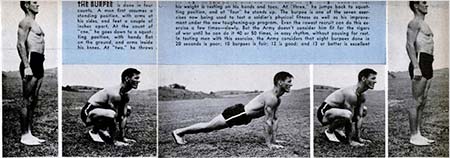
Royal Burpee’s original movement is performed from a standing position in four steps:
- Squat down and place hands on the ground.
- Jump your feet backward into a high plank.
- Jump your feet forward back to your squat position.
- Stand up and repeat for desired reps.
In the 1946 edition of his book, Seven Quickly Administered Tests of Physical Capacity, Burpee described a WWII military-level version of his test, in which burpee-doers would be asked to complete the move as many times as possible in 20 seconds and then in one minute. He stipulated that the test is only “suitable for men who have had a previous medical examination and are known to be free from cardiovascular disturbance.”
I believe Royal Burpee’s timing and movement standards are dead on with what we should be doing with the burpee today. Sadly, both standards are a far cry from what we see in the “modern” burpee. In the spirit of the movement’s originator, I am implementing a modern athletic style of burpee I shall name the “hard style” burpee.
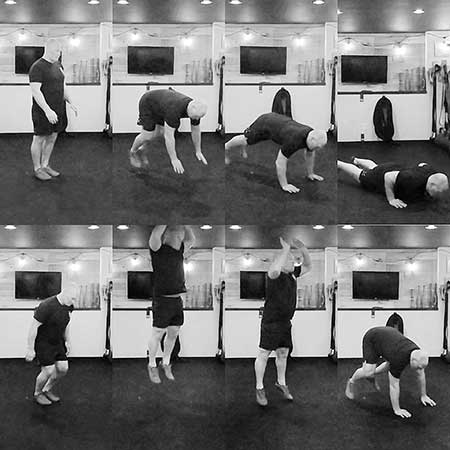
Task: Hard style burpee
Condition: The student will assume a tall posture with hands by their sides. Then drop to the ground quickly utilizing a hip hinge as you simultaneously kick your legs out behind you while at the same time assuming a two-arm plank position as you brace for your hands hitting the deck. You must lower your chest to the ground under control until the tips of the elbows are above the top of the shoulder and press back up explosively maintaining your tight torso while at the same time transitioning to a vertical jump with arms extended.
Standard:
- Hands should be shoulder width apart with the fingers slightly spread out pointing forward when on the deck.
- Elbows should be fairly close to your lats, at approximately a 45-degree angle from the spine.
- Neither your knees nor thighs may touch the deck.
- There is a distinct rigid torso on the way down and up with your pushup.
- On the ascent, there is a second hip hinge (not a squat) to set up for the jump.
- You must attain a true triple extension with your feet leaving the ground on the jump.
- While in the air, clap your hands overhead.
- Land under control and repeat for desired reps.
Programming the Burpee
With power output being the primary goal, I recommend doing sets of no more than ten with a distinct recovery between sets. If you think that is too easy, go faster or jump higher. If you start to lose tension in your core at any point or if you lose that explosive pop off the ground, end the set. Rest and adjust accordingly.
I have used the following 10 x 10 model for great “what the heck” results.
Hard Style Burpee 10 x 10 Plan:
This simple and direct way exemplifies the StrongFirst principles of “continuity of the training process” and “waving the load.” Ten minutes per workout with a goal of getting to ten hard style burpees per minute for 100 total reps.
- Hard Style Burpee, 10 minutes each day, 3 days per week
- Total Time Commitment: 30 minutes per week
- Total number of workouts: 12
This is a sample 10 x 10 program. Adjust the numbers according to your or your student’s ability level. If you want more pure power output instead of drifting into glycolytic territory, take more rest and do a set every two minutes for 20 minutes. The choice is yours.
It definitely starts out on the easy side, but quickly builds to some intense work.
I recommend you do this first in your training as your power output for the day.
Much like the 5-minute snatch test, if you want to really test your mettle (every now and again), give the 5-minute burpee test a go. I strongly recommend setting up jump height requirements along with the purposed hard style burpee standards to keep you honest.
Programming the Burpee and Swing Together
I have been doing this combo with my athletes for years now. Standalone sets of burpees followed by standalone sets of two-arm swings. Alternating back and forth between these two exercises and occasionally spicing it up with snatches.
10 to 1 Swings and Hard Style Burpees:
- The goal is to always keep both the swings and burpees explosive with ample recovery between sets.
- Use at least a 1:3 work:rest ratio. (10 seconds of work is followed by 30 seconds of rest.)
- Kettlebell size recommendation: one third to one half of your bodyweight.
- Goal: Power output.
- Totals: 110 Explosive Movements.
I love the Q&D protocol for this too. I just substitute the burpee for the pushup in 033 or you can also do the snatch protocol (044) with burpees instead for amazing results.
I will also note that if you can’t do the pushup part (which is the main area of form dispute for me) then I have one answer for you…GET STRONGER! Get your midsection and upper body stronger. If you start sagging in the midsection, the set is over. If the pushup is the issue, I would much rather have you do what I call an “athletic” burpee, meaning no pushup. This regression while you increase your strength is far superior to someone doing a compensation type of “worm” burpee.
I will also classify the “strict” burpee as maintaining all the qualities of the hard style burpee but without the all-out explosive effort. More of a controlled effort for those wanting higher rep counts. I liken this style to an 800-meter pace versus a 100-meter sprint.
Give the hard style burpee a chance. You will not be disappointed. Hold it up to higher standards and you will get great results. Combine the hard style burpee with kettlebell swings and you will build one powerful human.
Get better, get stronger and get more athletic.
Works Cited
- Brueck, Hilary, Business Insider, https://www.businessinsider.com/how-to-do-a- burpee-according-to-inventor-royal- burpee-2019-6
- Burpee, Royal Huddleston Seven quickly administered tests of physical capacity and their use in detecting physical incapacity for motor activity in men and boys. AMS Press, New York, 1972, 1940.
- Tsatsouline, Pavel, The Quick and the Dead: Total Training for the Advanced Minimalist, StrongFirst, Inc., 2019.
Learn more at our live events:
Strong Endurance™—Russian “anti-HIIT” that trains you to produce less lactic acid instead of tolerating more of it. Used by Russian national teams in a variety of sports: judo, cross country skiing, rowing, full contact karate…
All-Terrain Conditioning™—same as the above, minus the painful science, plus specific exercise instruction

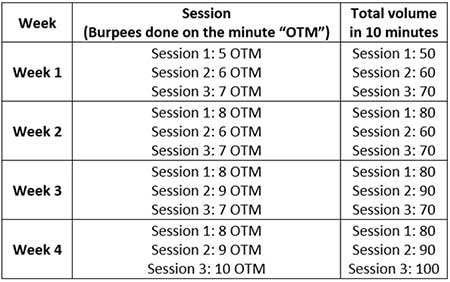
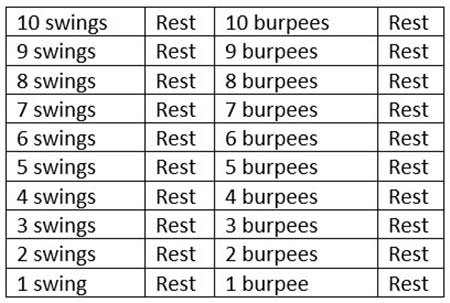
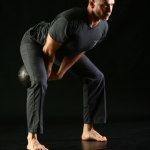

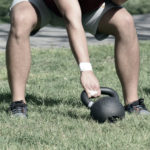






Burpees and Kettlebell Swings are two of my favorite moves but I’d never do them in the same session. It’s too hard and challenging lol. Thank you so much for the history and exact programming.
On way to take on more challenge
ENJOY! 🙏💪👊
Great 👍.
I use to do 10 hard style burpees every 3 minutes, between 6 and 10 rounds.
To do protocol 044 with burpees, is it better to do 10 burpees (~ 30 second effort) on the minute, or to use « anti glycolitic times », ~ 15 sec burpees, 45 sec rest ?
As with many things, it depends on your goals. I think time is a more accurate method to see how many reps you get. (Im about 10 HS burpees in 20 seconds) Speed wont lie in this regard.
As always, it depends on your individual goals.
Thanks for the nice article!
Played around with Swing+PU, Snatch+Dips, in an alternating EMOM AGT style with 5-10 reps and this is a perfect alternative to vary things a little bit.
Fantastic Max!
I’ve done a similar 10-1 SW/burpee ladder, but slightly different. Some may recall a “workout” called the Sissy Challenge from years past. It’s a miserable ladder starting with 25 swings (24kg)/1 burpee, 24 swings/2 burpees…finish with 1 swing/25 burpees. I’ve also done the reverse starting with 25 burpees/1 swing.
Anyways, I like SW/Burpees and just thought I would offer an alternative for the above training session.
Thanks Todd!!
Outstanding Mike! I have not done a 26 rep ladder due to losing my explosiveness (Im about 230 lbs) with that many reps, but I have a similar 11 rep version. I can stay powerful throughout.
Stay Strong
Terrific article Todd!
Thank you!
Burpees are always an excellent conditioning tool to plug in anywhere. After reading this article, it validates what I have been thinking for a while. I did the 10-1 workout yesterday after back squats. Felt great! Thanks for the article.
🙏💪👊
Peace and many Blessings to you and your family
Thank you for the great tips
🙏🙏🙏💪👊
Love this article! I’ve been playing around with burpees a lot since the lock downs last year. I’m glad to know that I’m not the only one who thinks that the burpee pairs beautifully with the swing!
Thanks! Stay Strong